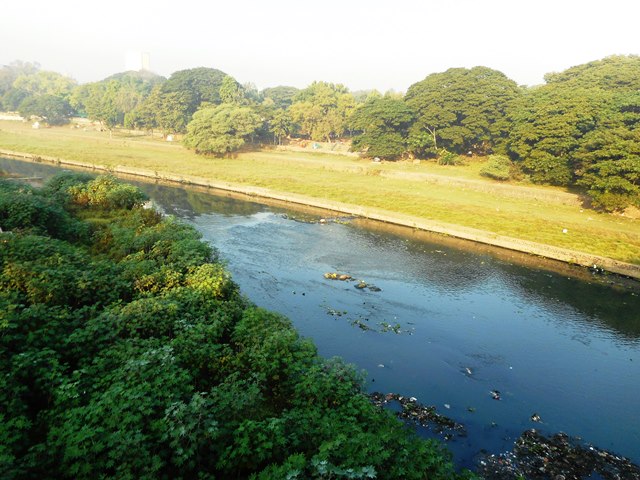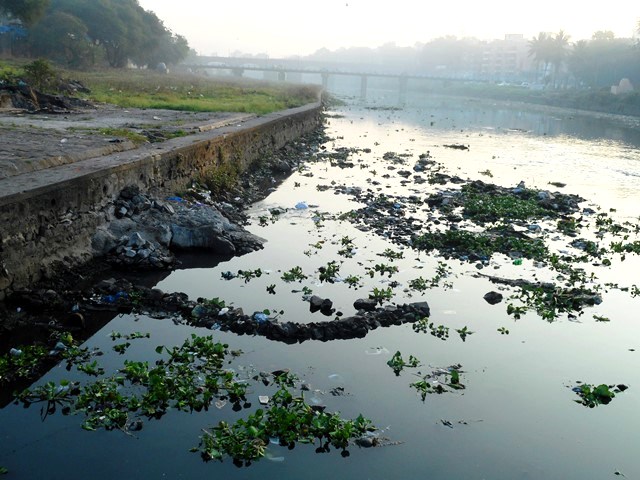The river Mutha, lovingly called 'Muthai'--meaning 'mother Mutha' in Marathi--is dying a slow death thanks to rapidly urbanising Pune which is depositing huge amounts of untreated sewage and dirt in its waters. However, the situation was different earlier. The river was revered and was a part of the everyday lives of the people in the city.
"Do you know the age of the Mutha river?", ask Manish Ghorpade and Anuradha Kodilkar who are conducting a walk as a part of the Muthai River Walk initiative organised by JANWANI and Jeevitnadi. The walk starts from the Siddheshwar ghats every Sunday morning, with the aim of connecting the people of Pune to their very own river, now forgotten and in a very sad state. "How can you hear the cries of the river unless you go and see it, understand her historical connect to Pune and the everyday lives of the people?", ask the hosts before they take us through the origin, history and the development of the city and the river.
Origin of the Muthai

The story of the river goes back to the times of a King named Gajanak who sat for penance in the Sahaydri mountains. This made Indra, the King of the Gods, insecure. So he sent two apsaras down to earth to break the King's penance. Gajanak, enraged with the two apsaras, cursed them and turned them into rivers that became the Mula and the Mutha flowing through Pune. He later told them that they could attain salvation when they flowed down to meet and form the river Bhima.
The river originates in the western ghats at a village named Vegre and as it flows down into the city, it is dammed at two sites on its way--one at Panshet and the other at Khadakwasla, both of which are the main sources of water supply to the city. It meets the Mula in the middle of the city at a common landmark known as the Sangam bridge. The Mula Mutha eventually meet the river Bhima and later the Krishna before they drain into the Bay of Bengal.
Age and history of the river
The Sahaydri mountain ranges from which the river originates is one of the oldest, and the Mutha river is known to be older than the Ganga. The geological age of the river can thus be traced to around 1 lakh years! Geological evidence shows that the banks of the river were covered by lush green, dense forests and were home to elephants, aurochs, and ostriches as fossilised remains of bones and ostrich eggs have been found near the river banks.
The river banks provided an ideal place for the gradual change from the hunter gatherer phase to the agricultural phase. The silt deposited from the river provided a rich ground for the agricultural food chain, and fish, amphibians, herbivores, carnivores, all flourished along with humans on the banks of this river. The city of Pune gradually developed as well. There were fourteen ghats on the river where people bathed and prayed. As the population of the city began to increase, attempts were made to explore other sources of water. Lakes such as the Katraj were constructed near the outskirts of the city and water from the lake was supplied through underground channels. This led to the gradual expansion of the city away from the river. But then, people were still connected to the river as it was associated with their everyday lives. However, this was to change as the city grew, as industries came up, and dams were built to take care of the water needs.

The present state of the river
Growth and expansion along with aggressive urbanisation and industralisation have taken their toll, and the city seems to have lost its connection with the river. A recent water quality report by the MPCB has found the Mutha to be one of the most polluted rivers along with Pavana, Indrayani and Bhima rivers in Pune district. The quality of the river water has undergone serious levels of deterioration due to heavy loads of domestic sewage and some amount of industrial waste that continue to be deposited in the river.
The Panshet dam burst in 1961 and washed away many of the ghats around the river. No attempt was made later to restore them and the river gradually lost its connection with the people, or vice versa. Only seven of the fourteen ghats remain now, and those too are poorly maintained. Of these, the Riddheshwar-Siddheshwar ghat from where the walk starts is unique with two temples of Lord Mahadev facing each other.
Some old pictures that the hosts have provide a glimpse of the large expanse of this once majestic, free-flowing river. A rich variety of birds such as Pied Kingfisher, River Tern, Little Grebe and Pheasant tailed Jacana dominated the surroundings because of a rich supply of fish in the full river. Now dammed at two places, it appears nothing less than a drainage as a number of pipes are seen opening into the river waters carrying all the sewage from the city, most of which is untreated as the city has the capacity to treat only 50% of the sewage it generates.
One look at the waters full of waste, garbage bags, cans, plastic bags and foam full of water hyacinth provides evidence that the death of the river is inevitable unless some action is taken. The beneficiaries of the degraded state of the river include scavenging birds and animals such as pond herons, crows and black kites along with packs of dogs roaming along its banks.

Around 50 years ago, there was so much water in the river that it was possible to jump off a bridge on the river and swim towards the ghats in the city. Now, channelisation has reduced its flow and no attempt is being made to retain even a minimum amount of water. This has taken away from the river water being able to meet some of the city's water needs.
Social activist Dr. Narendra Dabholkar started initiatives to prevent the river from choking further by trying to stop Ganesh Visarjan in the river. The movement has spread like wildfire and for the first time this year, the five main Ganesh idols--the pride of Pune city--were immersed in tanks rather than the rivers. "Change needs to start at the grassroot level. Only when this happens can policy level changes happen", says Manish.
Manish Ghorpade and Prajakta Panshikar add, "We want this walk to help to bring people together to look at their river, connect to her, understand her importance for our own existence, and help to do their bit to change her condition. We believe that the best way for change to happen is to start by actually visiting the place where it is needed to happen, where the river actually exists, to know and connect with how it evolved along with civilisations and humans. Then the seeds of change are sown in the minds of the people".













